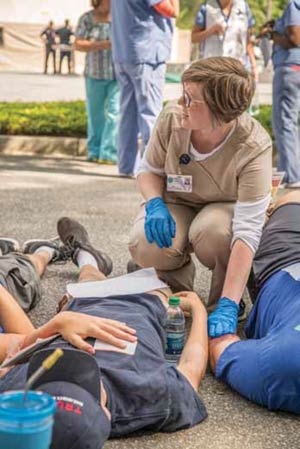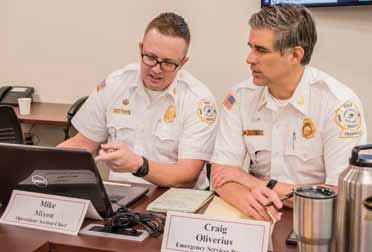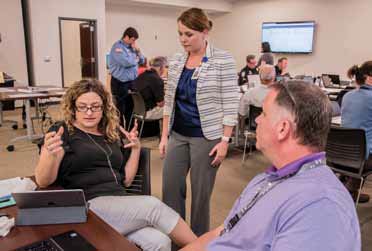
On June 4, the Lowcountry was rattled by a 5.5-magnitude earthquake. Many people were injured and some died. Buildings collapsed and the bridges that normally take motorists across the Ashley, Cooper and Wando Rivers and the Intracoastal Waterway were damaged and had to be shut down, at least until they could be thoroughly inspected.
On June 6, an aftershock brought more misery to the tri-county area. With transportation in and out of Mount Pleasant severely limited and East Cooper Medical Center bursting at the seams with patients who had checked in just two days earlier, the situation could only be described as dire. The injured were arriving on foot and in emergency and personal vehicles, but the only way out for those who required care elsewhere was by helicopter.
At Mount Pleasant’s Emergency Operations Center (EOC), a large room on the first floor of Town Hall, more than 30 employees representing most of the municipality’s departments labored to make decisions and take action that would save lives, assess the damage and return the town to some sort of normalcy.
None of this actually happened. It was all a drill for Mount Pleasant and other government entities preparing for what they would do if the Lowcountry were thrashed by a natural disaster such as an earthquake or a hurricane. Participants, all of them in communication with Mount Pleasant, included Charleston, Isle of Palms, North Charleston, Sullivan’s Island and Charleston and Dorchester counties.

If the emergency had been real, the EOC would have remained open for weeks or even months, staffed 24/7, with town employees working 12-hour shifts.
“In this case, it would have been months,” said Amanda Knight, Mount Pleasant’s emergency manager since last September. “The EOC would stay in operation until we recovered from the incident.”
Knight explained that in an emergency, activities would be assigned to four distinct sections.
Operations consists of “the boots on the ground,” the fire, police, public works and transportation employees responsible for search and rescue, fires, hazardous materials and, because of road and bridge damage, traffic management.
Planning collects information from Mount Pleasant’s partner agencies and distributes it to town officials and residents and is also responsible for creating a plan to help the town react to the emergency.

“We want to make sure we have a clear understanding of the progress we have made and what we would like to accomplish so we can stay on task and move toward recovery,” Knight explained.
Logistics makes certain the town has the equipment and supplies it needs to stick to the plan, while Finance measures the expense of the town’s response and makes sure all costs are documented and that the town is able to obtain any materials it might need to save lives and repair damaged infrastructure.
All four sections work together to get the job done.
“For example, if a building collapses, a search and rescue team needs to stabilize the structure,” Knight said. “We might need materials that we don’t have, such as lumber, to shore up the building. Our Operations section determines that the search and rescue is necessary and asks Logistics to come up with the lumber. If the town doesn’t have those materials, Logistics asks Finance to obtain them, either from another level of government or from a private contractor.”
In a real emergency, in addition to saving lives, the town would have to deal with critical infrastructure, such as roads and bridges. Knight said Mount Pleasant also would help other entities get back on line, if necessary, such as hospitals and gas, electricity and water providers.
“Emergency management is a whole community approach,” said Knight. “It takes the government, the private sector and individual households. Public/private cooperation is essential.”
Knight cited another hurdle the town would have to navigate if an earthquake or hurricane caused severe damage to East Cooper’s roads and bridges. Many Mount Pleasant employees who are essential to the EOC live on the other side of one or more of the rivers that wind their way through the Lowcountry. Knight said once they made it to Mount Pleasant, they would be provided with a place to live as long as the EOC remained open. She added that some employees might have to reach the town by boat.
While town employees were preparing to deal with the overall effects of a natural disaster, administrators and health care personnel at East Cooper Medical Center were practicing how they would react if dozens of injured people showed up at an already-overtaxed hospital. In the parking lot was a triage tent, where, in a real emergency, doctors and nurses would determine who would be admitted to ECMC and who would have to be transported by helicopter to another medical facility.
On June 6, volunteers, some of them from a local Boy Scout troop, showed up at the triage tent with a variety of “fake” medical issues, from burns and broken bones to injured eyeballs.On June 6, volunteers, some of them from a local Boy Scout troop, showed up at the triage tent with a variety of “fake” medical issues, from burns and broken bones to injured eyeballs.
According to East Cooper Medical Center Chief Executive Officer Patrick Downes, the hospital’s capacity could be increased from 150 beds to around 200 beds by putting two patients rather than one in some rooms.
“This is an important drill for us,” Downes commented. “Staffing and planning is important. We have to have a plan.”
When asked if he thought the hospital would ever be faced with a similar situation that was real instead of simulated, he responded: “I hope not. But we have to be prepared.”
Back at Town Hall in the EOC, Mount Pleasant employees were practicing for a disaster that might or might not come. The exercise was a worthwhile endeavor, according to Town Administrator Eric DeMoura.
“This exposes us as an organization in a good way,” said DeMoura. “It would be a mistake if we didn’t find out where we are weak. It’s a challenge for everyone to find out not what our capabilities are but what they aren’t.”
By Brian Sherman

Leave a Reply